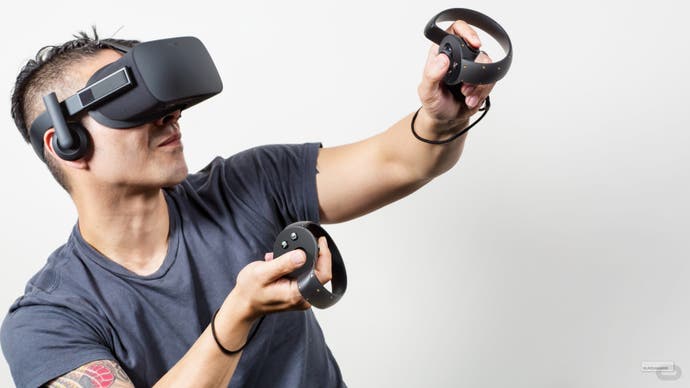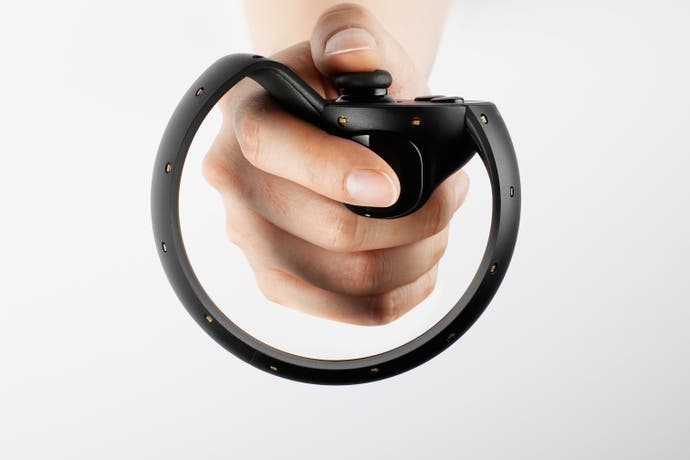Oculus Touch is the gold standard in VR control
Hands-on with the sensational E3 demo.
Perhaps the hottest appointment at this year's E3 was a chance to try out the prototype Oculus Touch controllers. Such was the buzz around them that it took some persistence just to get my foot in the door. I'd been booked in to try the final Rift hardware (and very much enjoyed a slice of Insomniac's action-adventure Edge of Of Nowhere on it), but getting a go on Touch necessitated a favour from an old friend and a willingness to hang around Oculus' meeting rooms for an hour late on Thursday afternoon, the show floor winding down somewhere below and the time of my flight back to London creeping ever closer, while Sony's Shuhei Yoshida and Epic's Mark Rein made friendly small talk on the sofa across for me.
It was worth it. The demo is extraordinary - almost as revelatory a VR experience as Valve's SteamVR suite - and the controllers themselves represent a new gold standard in virtual reality interfaces: better than Sony's use of twin Move controllers, better than Valve's prototype wands, and light years removed from the conventional controls of the Xbox One pad that will ship with Oculus Rift when it launches in Q1 next year. (Oculus' ebullient CEO Brendan Iribe, emerging from his meeting with Yoshida, told me that Touch won't be too far behind - the firm is aiming for a Q2 launch for the controllers.)
Before I get too carried away, a couple of caveats. First: both Move and Valve's solution are also very good, and based on the same basic principle - you grip one controller in each hand and both are subject to three-dimensional motion tracking, giving you two virtual hands with which to manipulate objects around you in virtual space. Move is a simple and effective solution for this which is already proven and comes at a low cost, both to players and to Sony - an easy win. Valve's wands feature scroll wheels (rather like those on an old iPod) with neat haptic feedback that are a good solution for tasks like menu selection.
Where Touch wins out is in ergonomics. The controllers, which closely resemble wireless Wii Nunchuks with a sensor loop encircling your fingers, are supremely light and comfortable, and unlike Sony and Valve's wands don't extend past your grip. Weight distribution is a non-issue and you quickly forget you're holding objects, the controllers melting away to become part of your hand - another little barrier to the illusion of presence in 3D space removed. And though I didn't get to use the thumbsticks and face buttons, they add a welcome layer of compatibility with more traditional game controls.

The second caveat concerns the quality of the motion tracking, which was superb, exceptionally accurate and low in latency. But I tried the controllers in a dedicated demo space: a relatively spacious room-within-a-room lined on walls and ceiling with something that looked like soundproofing foam. So the demo hardly took place in real-world conditions. (Also, the tracking currently requires two sensor cameras, although Oculus hopes to get this down to the one that ships with Rift by the time of Touch's release.)
Nevertheless, it was easily the most thrilling five minutes I spent at E3. There was nothing too remarkable in what I was doing, at first. Presented with a virtual tabletop, I used the controllers to grip, move, throw and stack geometric objects. I slapped at a ball on a string, played with fireworks, and used a slingshot and laser pistols at a fairground shooting gallery.
Two things made this simple VR demo unforgettable, however. The first was the sense of natural ease in every interaction - and this is down to the brilliant, logical simplicity of the interface design. Each of the controllers has two triggers; the first, under your index finger, is used for the deliberate interactions you'd expect, such as pulling the trigger of a gun. The second, under your middle finger, makes your virtual hand into a fist. This is the key to Touch, because making your hand into a fist does two things. It makes it solid, offering resistance to objects in the game world, so you can push a toy car along the table or punch a volleyball. And if your open hand is placed over an object, making a fist grips it. So, when using the laser pistols, I was pulling the middle-finger trigger all the time to hold them, and then the index-finger trigger to fire.
This twin-trigger set-up, in conjunction with the two states of your hands - open and intangible, closed and solid - is so instinctive and practical that it becomes second nature within, well, seconds. I predict it will quickly become the de facto standard design for VR interaction.

The second remarkable aspect of the demo was that there was another person in virtual space with me. A demonstrator stood opposite, across the virtual table - although, weirdly, he was stood in a demo room behind me in the real world, a fact that even now my brain recoils from uncomfortably. Speaking in my ear, he was present only as a disembodied, see-through head and two floating hands - the ghost of Rayman future. We played fluid, natural table tennis and shot fireworks in each others' faces.
This was my first experience of multiplayer virtual reality, and it's hair-raising, uncanny stuff. The Touch controllers allow you to point and make thumbs-up gestures simply by lifting your index finger and thumb away from the device, so my companion could gesticulate convincingly and point with precision to anything in the virtual space we shared. As ethereal as the bobbing, translucent head and hands were, I've never experienced such a strong sense that I was sharing a game space with another human being. Who needs exclusive emotes when you can make your own?
Though sidelined somewhat in the major press conferences, VR had serious momentum on the show floor at E3; I'll be taking a look at all the major players, including Sony's Morpheus, the new StarVR headset and Microsoft's remarkable but compromised alternative HoloLens, in a future article. It's a thrilling field, and still a very unproven one. It's important to remember that the world of video game technology has seen gold rushes very like this one before, which subsequently petered out - not least around motion control after the success of Nintendo's Wii. But all that work on motion control may pay off in the end, if it gets the VR pioneers one step closer to solving the many problems of this nascent technology and potential art form. Oculus Touch suggests that it has.





.png?width=291&height=164&fit=crop&quality=80&format=jpg&auto=webp)



